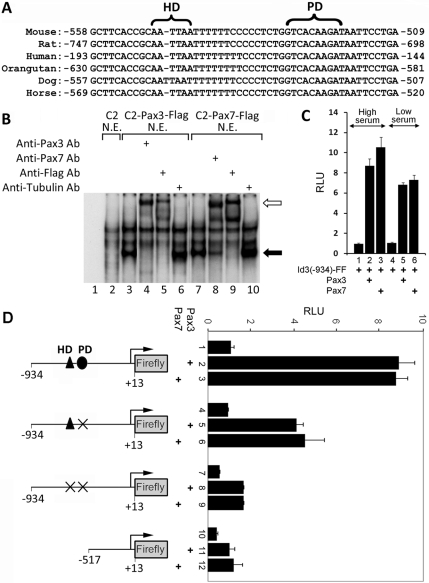Figure 3.
A conserved Pax3/7 binding site is present upstream of the Id3 promoter. (A) Conserved HD and PD binding sites are present upstream of the Id3 promoter in several organisms. (B) EMSA using an oligo encoding the HD/PD binding sites upstream of the mouse Id3 gene with nuclear extracts made from parental C2C12 cells or polyclones expressing Pax3-FLAG or Pax7-FLAG. Anti-Pax3, anti-Pax7, anti-FLAG, or anti-tubulin were added to the EMSA as indicated. Pax3/7 gel shift is indicated by the black arrow; antibody supershift is indicated by the white arrow. (C) Serum factors affect Pax3 or Pax7 mediated induction of the Id3 reporter. C2C12 cells were cotransfected with pGL3-Id3(−934)-firefly luciferase and pSV40-Renilla-luciferase. In addition, the cells were cotransfected with either Pax3 or Pax7 expression vectors, as indicated, and grown in presence of either high or low serum. The relative luciferase units (RLU) of pGL3-Id3-firefly luciferase and pSV40-Renilla-luciferase are displayed. (D) Pax3 and Pax7 induction of an Id3 reporter requires both HD and PD binding sites in the Id3 promoter. C2C12 cells were cotransfected with either pGL3-Id3(−934)-firefly luciferase (containing the wild-type Id3 promoter) or mutated versions of this reporter lacking HD and PD binding sites as shown, plus pSV40-Renilla-luciferase. In addition, the cells were cotransfected with expression vehicles encoding either Pax3 or Pax7, as indicated. The RLUs of pGL3-Id3-firefly luciferase and pSV40-Renilla-luciferase is displayed.

